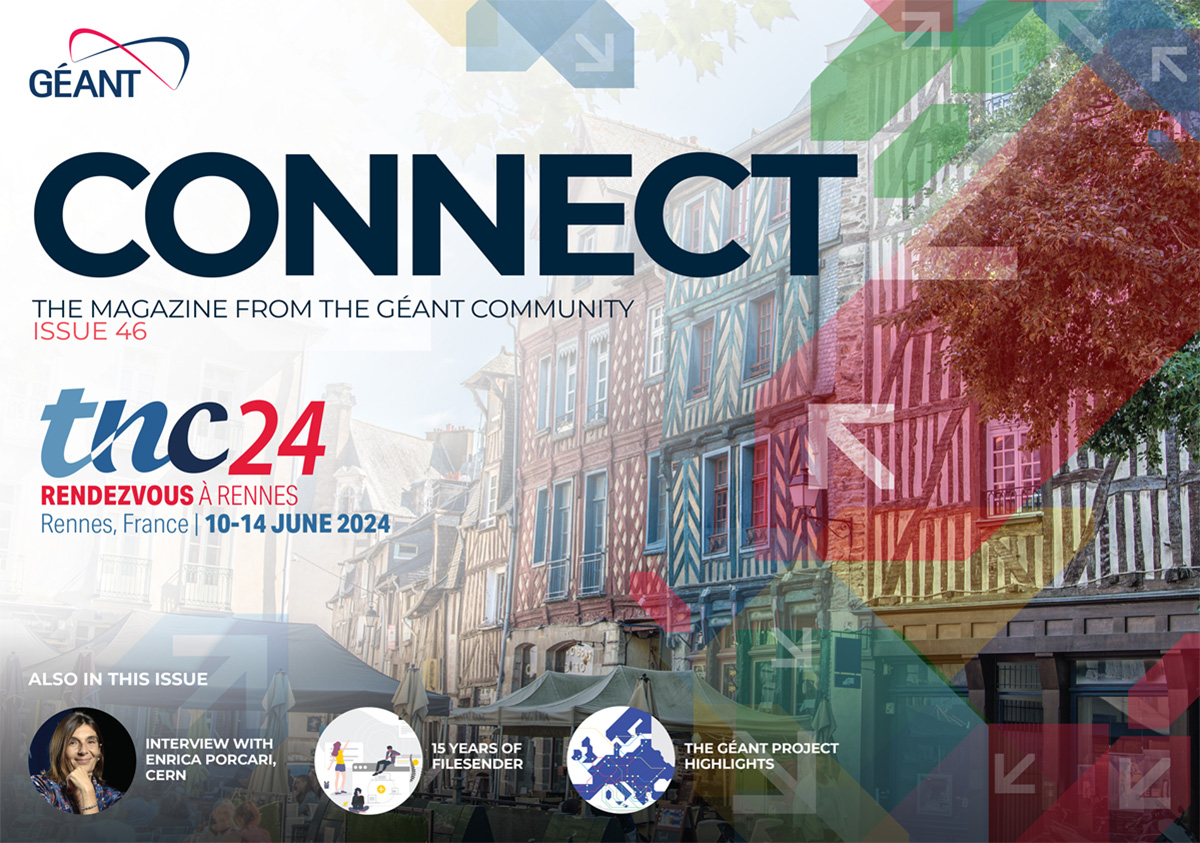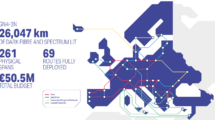Head of the Information Technology Department at CERN since 2021, Enrica Porcari leads a talented and enthusiastic team with whom she is pushing the boundaries of innovation and technology, focusing on serving not only CERN’s IT requirements but also those of the larger scientific community. Before joining CERN, she managed the digital aspects of several international development projects. She was Chief Information Officer at the World Food Programme, where she played a key role in setting up the Fast IT and Telecommunications Emergency and Support Team to support global humanitarian operations.
We interviewed her to learn more about her career, her team’s work and her take on the future of international collaboration within the high-energy physics community.
Enrica, can you tell us more about what brought you to CERN? As you come from outside the world of high-energy physics, we are curious to know your story and how it led you to the Information Technology Department at CERN.
CERN is a very inclusive international research organisation and among the best-known in the world. Its success story is due to the contribution of thousands of people with many different profiles, and I am proud to be one of them. This year, CERN celebrates 70 years since its founding, a long and proud history of ensuring research in fundamental physics reaches society at large. A fascinating journey, a compelling story of science, innovation and impact.
From my end, when I joined CERN, I had already managed Information Technology (IT) teams in large international organisations for 30 years. The field I was coming from was that of the international humanitarian organisations, where I developed a deep understanding of the societal needs, so well described by the UN Sustainable Development Goals. Joining CERN was an unmissable opportunity for me, I could both support first-hand the great work of this Laboratory and its IT department to serve CERN’s mission of fundamental research to understand the origin of the universe, and at the same time build ways and envision solutions that are, or will be, beneficial to society at large. A dream come true.
Science is our driving force at CERN, but it’s not an ivory tower that keeps us away from the rest of society. A very good example are all our initiatives in the field of open science and the hundreds of software packages developed at CERN and shared with society. Just an example – it was recently announced that the World Health Organization (WHO) and CERN have collaborated to develop a robust risk assessment computer model for indoor airborne pathogen transmission based on tools developed for particle physics. The list of such initiatives is long.
In an online interview, you compared your work to that of “running a restaurant”, meaning catering for the needs and requests of the clients while not bothering them with what happens behind the scenes, “in the kitchen”. What does a typical day at work look like for you and your team?
We like what we do, and the IT department is proud to contribute to the tools and platforms the innovative physics research of CERN needs. We obviously serve CERN’s internal computing needs but, very importantly, also serve collaboratively a growing community working in the larger scientific community. We have to work in sync with, and at times anticipating, the needs of our internal and external users – “the clients”, if you will.
Just like in a restaurant, these clients do not necessarily need to know the ingredients or ways the food is prepared in the kitchen, they just want to have a meal they like and want. There is no magic formula for that, just hard work and a mutual understanding of all people involved. Yes, in the IT Department, a huge effort goes into making sure that what we do matches what the research community needs, like a good chef would do to make their customers happy when they taste the food. To do so, we establish and everyday nurture strong collaborations with our own customers to make sure we continuously check progress, verify expectations, make them ‘taste the food, before it is ready’. In that way, we are actually quite a unique and collaborative restaurant, where we also ensure the kitchen staff works as a team!

In September 2023, CERN passed the threshold of one million terabytes of disk space. These disks are primarily used to store the impressive amount of physics data produced by the LHC’s experiments. HL-LHC, the upgrade of the LHC, is expected to generate even more data. How do you prepare for such a data deluge and the work that follows?
Dealing with huge amounts of data is our daily activity. We know already that what seemed like an incredible record and a challenge just a couple of years ago – the production of 1 PB of data – will soon be the amount of data that our storage facility will receive every day.
The recent successful outcome of the ALICE O2 project provided us with a useful preview of what we should expect from High Luminosity-LHC. Because of recent upgrades to the detector and also the data readout strategy, last Autumn, the ALICE experiment produced 50 PB over five weeks, generating up to 3.6 PB of data in a single day.
As I said, our mission is primarily to meet the needs of the scientific community managing the experiments. For them “failure” is not an option. Our teams collaborate constantly with the researchers, they innovate, they optimise. It’s a daily effort, there is no miracle solution, it’s pure human ingenuity and hard work. For ALICE O2, our teams set up a dedicated high-performance storage system consisting of approximately 12,000 hard disks across 126 servers with 100 GE network connectivity between the experiment – located in France – and the data centre – located in the main campus.
Besides CERN’s two data centres – the one in the Prévessin campus was inaugurated last February – our community can also count on the vital role of the Worldwide LHC Computing Grid (WLCG). To date, there are around 160 WLCG sites in more than 40 countries. Collectively, in WLCG, we have a storage availability of more than 1 EB on disk and almost 2 EB on tape. The experiments use over 1M cores (processing units) from WLCG (on average at any given time). So, once again, dealing with the challenges is the result of a collaborative effort.
Created in response to the evolving needs of the LHC experiments, the Large Hadron Collider Open Network Environment (LHCONE) has proved to be the single most successful multidomain services provided by the global R&E network community, creating a closed and trusted environment, and enabling institutes and scientists around the world to participate in CERN’s research. A remarkable example of the benefits of international collaboration within the high-energy physics community. How do you see this collaboration evolve in the future?
Past evolution of the LHCONE network has been driven by the needs of the LHC community—the improvements in connectivity between our partners in Asia are a good example. There is still a need to improve connectivity in less developed countries and address the needs of small sites, but I think evolution in the future will also reflect the growth in global “big data” science. Today, global R&E traffic is dominated by data from the LHC but we’re soon going to be sharing those links with others, the SKAO community, for example. It’s great to see how the LHCONE community has been preparing for this with initiatives such as SciTags that enables monitoring of the traffic flows from different communities. I’m also pleased to see that there will be a Global Science Network Forum at TNC24 which should help to ensure that other communities can benefit as much from close contact with the Global R&E networking community as we have at CERN.
How do you envision the future of the IT Department and the evolution of the computing environment at CERN and beyond? What is the role of Education?
From my experience in technology management, I have learned that there is virtually no other field like Information Technology, in that it proves so difficult when one attempts to do forecasts about the way it will develop and the depth of its impact. Who would have known that back in the 90s CERN’s innovative work on HTML would have grown into what is today’s worldwide web, something everyone uses?
We work with Artificial Intelligence, Quantum Technologies, High-Performance computing, ultra-fast networks. This is the present. What will the future bring? I hope – and we are working for this to happen – that it will bring no new technology gaps. This is one of the reasons that pushed us, among others, to launch the Open Quantum Institute, an initiative that aims at envisioning how the quantum technologies can benefit society while they are being developed, not after. We also invest considerable resources in training future computer scientists. In 50 years of activity, we have organised more than 60 schools in 20 different countries. In 2024, in addition to summer camps at CERN, we are running four different computing schools to provide early careers scientists with advanced learning in scientific computing and the opportunity to connect with other young scientists and engineers involved in particle physics or other sciences. And yes, the incurable optimist I am believes that tomorrow’s world will be better. At CERN we have the motivation, the skills, and the tools to contribute to make it happen. And the IT department is an integral part of that effort.

Read or download the full magazine here







